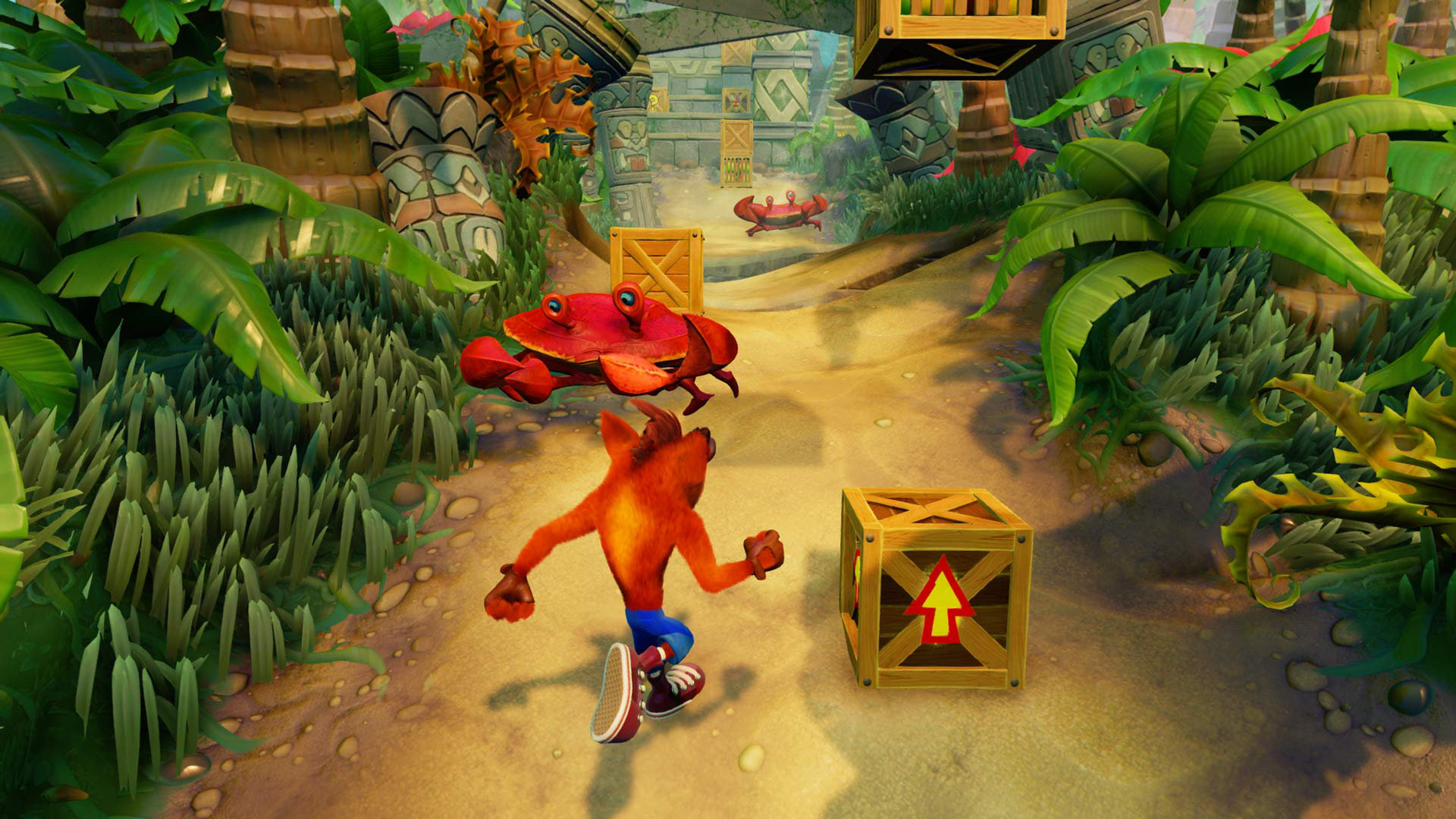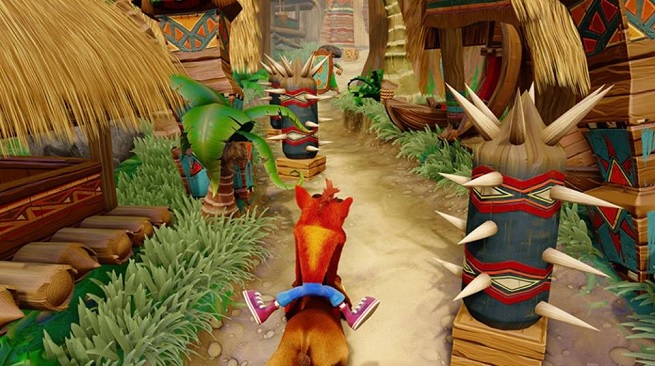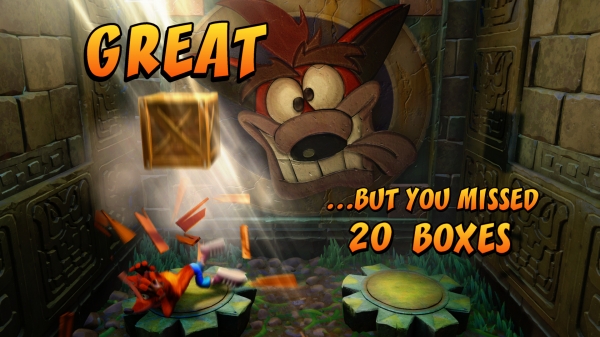Review: Crash Bandicoot (N. Sane Trilogy)
Written by Ben Vollmer
This is a review of the first game in the “N. Sane Trilogy” and is not indicative of the package as a whole.
On a mechanical level, Crash Bandicoot is broken. This is a shame, because the game is jarringly simplistic in its movement as it is. In large part, this can be attributed to the game’s 1996 release date, but we had already seen titles like Super Mario 64 which had shown us how complex 3D platforming and movement could be. It’s also problematic that the remade versions of the game in the Crash Bandicoot N. Sane Trilogy are notably more difficult, which is more of a result of bad hit box redesign than anything else.
Most importantly, Crash Bandicoot relies upon a fixed camera point of view. It makes sense, especially because other 3D platformers like Super Mario 64 had notably terrible cameras, and it’s one of the game’s few redeeming qualities. Given that the game flips between 2D and 3D level design, the only real issues come during moments where something seems a lot closer or further away than it actually is. Luckily, the game pairs you with a shadow of Crash’s body, providing a decent landing projection on any and all jumps.

On his own, Crash Bandicoot is pretty unremarkable. He can spin, jump and run forward or backward. The odd juxtaposition between the game looking modernized and its mechanics feeling incredibly antiquated is another blemish on the title. The spin provides little interest and it often serves as more of a frustration than anything else. Whenever Crash spins, he has the ability to knock out foes or destroy the boxes filled with Wumpa Fruit, the main collectable that seems eerily reminiscent of Mario’s coins. Unfortunately, that same spin has the ability to knock collectables out of the way, so an ill timed spin can force a restart if you’re looking to collect everything. Even worse, the attack move doesn’t work very well against enemies and seems to have a much smaller hit box when it comes to benefiting Crash than it does to knocking away the collectables.
The game isn’t entirely iterative, and it does have the extremely unique, vertical level design that is so often paired with chase sequences in other games. It certainly produces an interesting perspective, and it’s worthy of note that the game’s best levels are from this point of view, but not a whole lot is actually done with it. The most interesting moments come when there is a sense of urgency, whether at the threat of being crushed by a boulder or on the back of a wild hog. Crash Bandicoot is at its best when it’s nutty protagonist is united with a manic pace.

Unfortunately, the pace slows to a crawl when the game asks you to wait on a rotating platform or a (almost hilariously) slow enemy to get out of your way. It would be as if Sonic was forced to stop after every five seconds. Without any real mechanism of “forcing” your way through enemies, many of which require being jumped on top of, having to stand by while they prod their way into position can be an absolute bore. Especially when half of the time you’re met with a terrible hit box that has Crash dying despite landing in good position.
Crash Bandicoot is a low in many of platforming’s most important core mechanics: hit boxes, movement and pacing. After so many years, it’s difficult to understand the popularity of the series until you play the second and third games in the franchise, but there’s still some things to be loved about the frenetic mascot’s introductory title.
First and foremost, the art design behind the remake of Crash Bandicoot N. Sane Trilogy is astounding. Both the background and forefront have seen a significant upgrade – one that actually warrants the title of “remake” instead of a “remaster” – and it’s not surprisingly that an already colorful franchise remains vibrant in design. The design doesn’t jive all too well with simplistic mechanics, but it’s a nice fallback for when the rest of the game fails you.
Crash Bandicoot also provides a really nice starting point for what would eventually become an illustrious platforming franchise, and there’s good reason for that. The concept of item collection is largely borrowed from other platformers, but there’s unexplainable joy and satisfaction in crushing the crunchy boxes that stand in Crash’s path. The boxes are often strategically placed to make your life more difficult, and for a game that has so many frustrations, it’s hard to imagine too many people fighting their way through the pain. Those who do will surely have a strong grasp on the various level designs, something that feels starkly unique about the game’s primitive concept.
Level design, in large part, is where Crash Bandicoot has the most success. Often giving players several avenues to get from one point to the next. Not all of them seem intentional, such as the bizarre rope walking you can do in a couple of later levels, but the game makes it very apparently that the straight and narrow path isn’t always the easiest or best way forward. Aside from the aforementioned pacing and enemy placement, the wonderful mix of horizontal and vertical platforming is almost unmatched. Not to mention, the game does make an honest attempt at using enemies as a trampoline for Crash to make jumps, the bad hit boxes just make this more of a drag than a fun concept.

There are a lot of smaller things that make Crash Bandicoot a poor entry point to the series. The game is plagued by odd design decisions, including the inability to pick up lives that have already been collected after game overs. Especially for new players, getting a game over just makes things more and more difficult. Instead of feeling more confident after each attempt, Crash Bandicoot confiscates the player’s will power by making things more difficult with each attempt. Combine this with the fact that many of the game’s levels rely on trial and error (like randomly placed TNT boxes that will explode the room or jumps that you can’t see the other side of), lives are such a precious commodity. Stripping the ability to gain more makes repeated play throughs of a level an absolute chore.
Much like its mascot, Crash Bandicoot is a total screwball. It simultaneously provides the groundwork for what would become one of gaming’s most renowned platforming franchises and also seems entirely devoid of practical game design. Crash Bandicoot is an enigma; one that can be enjoyed but not lauded.
Score: 5.0
